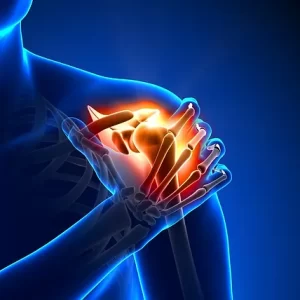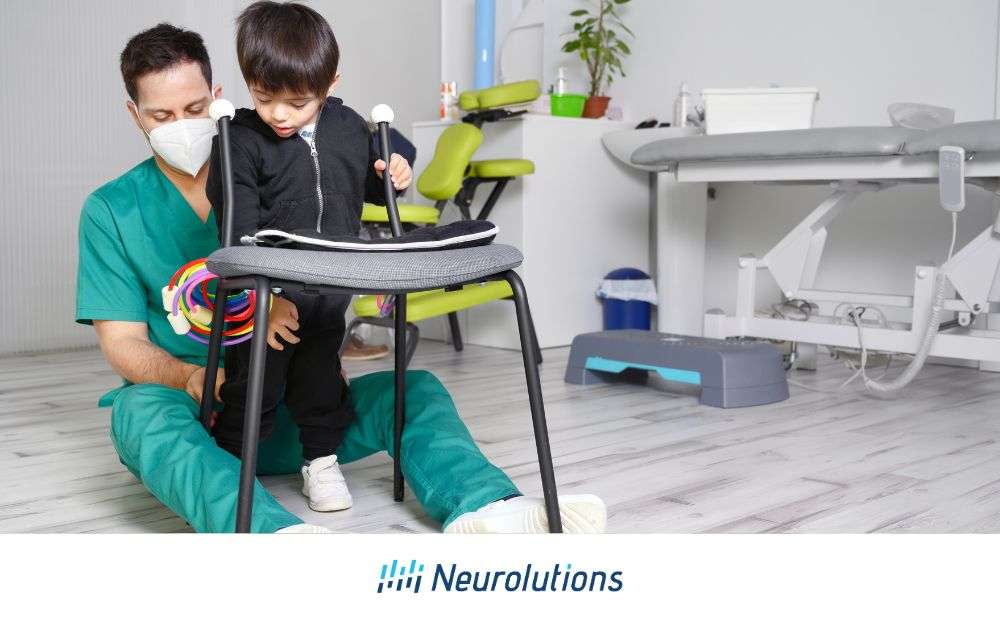Understanding Shoulder Subluxation and Its Causes
Shoulder subluxation is a significant issue in poststroke hemiplegia. It often results in pain and loss of function. Shoulder subluxation, also referred to as glenohumeral subluxation (GHS) is a common post-stroke complication that affects up to 80% of stroke survivors (1). This complication happens due to muscle weakness, paralysis, or spasticity, a condition in which there is an abnormal increase in muscle tone or stiffness in the muscle (4). Weak muscle strength results in the arm bone being pulled into an abnormal position, causing subluxation.
(3).
Preventing shoulder subluxation in the early stage of stroke rehabilitation is very important. Shoulder subluxation can cause difficulty performing functional daily activities, which can decrease your quality of life. A change in normal muscular function that occurs after having a stroke presents a potential risk for subluxation. Therefore, focusing on upper limb rehab after having a stroke, such as range of motion and strength exercises, is crucial in pain and loss of function (4). Some supportive devices can help prevent subluxation of the shoulder, depending on your condition and a medical professional recommendation. Devices may include slings, lap trays, pillows, and foam support to help keep the arm and shoulder supported in the correct position (1). In this article, you can learn more about shoulder subluxation and how to prevent it after having a stroke.
What is Shoulder Subluxation?
A shoulder subluxation occurs when the glenohumeral joint dislocates partially or completely. There are three different types of shoulder dislocation. There is anterior (forward), which is when the head of the humerus bone is moved forward and in front of the socket. There is also posterior (behind), which is when the head of the humerus bone is moved back and above the socket. L lastly, inferior dislocation (bottom), which is when the head of the humerus is pushed down and out of the socket toward the armpit (5). When a shoulder is dislocated, it may cause damage to the surrounding tissue, such as:
- Ligaments
- Cartilage
- Tendons
- Muscles
- Nerves
- Blood vessels

What Causes Shoulder Subluxation in Stroke Survivors?
Changes in Muscle Tone
For some in the first stages after stroke, your hemiplegic arm may be flaccid. This is a type of paralysis in which a muscle becomes soft and weak, or hypotonic (low muscle tone). The shoulder muscles cannot hold the arm within the shoulder joint, resulting in a high risk of shoulder subluxation (1). Since the arm is so weak, gravity pulls down the arm. The arm’s weight causes the humerus to drop lower in the socket because the muscles cannot hold it into place if there is not enough shoulder support. In addition, during the flaccid stage of stroke recovery, your body tends to lean towards the hemiplegic side of your body, causing your scapula (shoulder blade) to descend from its normal position. Your trapezius, which is the muscle responsible for posture and shoulder blade movement, and serratus anterior muscles, which help the shoulder blade move, become weak and soft which causes the shoulder blade to rotate downward. Without normal muscle tone, the rotator cuff can no longer hold the arm in the shoulder joint, causing shoulder subluxation (8).
Poor Posture
After stroke, trunk and pelvis malalignment from weakened core muscles is a common problem. The entire chain of the human body is influenced, including decreased capacity of the diaphragm and lung expansion, strained voice production, impaired swallowing, and balance. There are also orthopedic consequences that develop when there are postural alignment issues in the neck, spine, and hips. Muscular imbalances in important muscles of the back, shoulder blade region, and neck may equate to pulling of the humeral head and contribute to shoulder subluxation.
Damage from External Influences after the Stroke
Improper position during sleep, while walking, or even sitting, may cause the head of the humerus to be forced or gradually pulled out of this socket. This can happen traumatically, but most often it occurs over time.
Orthopedic trauma may contribute to shoulder subluxation as well as cause pain and further damage. An example of this is when the arm is pulled during a transfer. Another example is when the individual or helper passively stretches their arm beyond limits that condone safe muscle balance.
While it is important to promote movement in the arm and engage in daily activities, muscle imbalances along the chain of the trunk, scapular muscles and shoulder while reaching may not condone healthy rhythm of important muscle groups. The consequence of this may be microtears in the shoulder muscles that develop into pain. This will likely cause reluctance to use the arm, stiffness, and weakness that could factor into impingement, subluxation, or gradual tear.
Untreated Shoulder Subluxation
If your shoulder subluxation is not treated, then it may cause more complications in the future. Delaying the recovery of upper extremity function may cause adhesive capsulitis (frozen shoulder) and/or reduced proprioception (sense of body positioning in space). A frozen shoulder is characterized by a lack of active and passive range of motion in the shoulder from progressive pain and stiffness due to lack of movement for a number of months. Risk factors for shoulder subluxation include severe loss of motor function and absence of the supraspinatus muscle (rotator cuff muscle) contraction, pulling on the hemiplegic arm while being transferred, lack of support in the upright position, and improper positioning throughout the day.
Symptoms of Shoulder Subluxation:
- Swelling in the shoulder
- Pain in the arm secondary to nerve disruptions through the joint
- Inability to move the arm and shoulder
- Malformation
- Weakness of the arm
- Numbness or tingling in the neck or arm
- Spasms in the muscle that makes the pain hurt worse
- Tearing of the muscles around the shoulder joint
- Damage to the blood vessels or nerves
- Instability in the shoulder
Preventing Shoulder Subluxation for Stroke Survivors
Education
Education to the individual who had the stroke and their entire care team is key. Some causes of shoulder subluxation are preventable. It also must be managed appropriately so symptoms do not worsen, but so the individual has opportunity for improving arm and hand function. Ensure family members, therapists, and other helpers understand the importance of safe handling and following guidelines outlined below.
Exercises for Shoulder Subluxation
Exercising and stretching the shoulder muscles can improve the range of motion of the shoulder joint and prevent shoulder subluxation. Before you perform any exercises and stretches, consult with your medical professional to make sure they are safe to perform. Consequently, if you suffer from shoulder subluxation following a stroke, you can perform safe shoulder rehabilitation exercises to retrain the brain and body to move correctly. With proper body mechanics, time, and consistency in a rehabilitation protocol, the humerus will be encouraged to stay in the socket while improving your overall shoulder mobility and function.
One of the main benefits of exercise for shoulder subluxation is increased muscle strength and stability. Strengthening exercises that target the rotator cuff and other muscles around the shoulder can help support the joint and prevent it from slipping out of place. This can lead to improved shoulder stability, less pain, and greater ease of movement.
Another benefit of exercise is improved range of motion. Stretching and range-of-motion exercises can help reduce stiffness in the shoulder joint and improve flexibility, making it easier to perform daily activities like dressing, grooming, and reaching for objects.
In addition to these physical benefits, exercise can also have a positive impact on mood and overall quality of life. Regular exercise has been shown to reduce stress, anxiety, and depression, all of which can be common after a stroke. By improving physical function and mental well-being, exercise can help stroke patients regain independence and a sense of control over their lives.
If you are experiencing shoulder subluxation after a stroke, it is important to talk to your physical or occupational therapist and physician about incorporating exercise into your treatment plan. They can help you develop an exercise program that is safe and effective for your individual needs and limitations. With their guidance and support, you can work towards improving your shoulder function and overall quality of life.
To prevent damage to the muscles, ligaments and joint capsule, passively stretching the arm past 90-degrees of elevation in any direction should be avoided even if the arm is not painful with subluxation.
If you have any difficulties or pain throughout any of the exercises and stretches, stop performing them. Consult with your medical professional in order to determine the best upper extremity rehabilitation protocol.
Wearable Braces for Shoulder Subluxation
Specific braces may be beneficial for you and your shoulder subluxation. Consult with your healthcare provider before buying and using any braces. Braces are essential for repositioning the humerus back into the socket and protecting the shoulder joint from subluxation.
Shoulder Slings
A shoulder sling can reduce the stress on the shoulder in addition to supporting the weight of the forearm and hand.
Shoulder Brace
Shoulder braces support the space directly around the shoulder joint. These braces anchor across the body in order to reduce shoulder stress. Wearing this type of brace can cause the arm to feel heavy and uncomfortable since shoulder braces do not support the forearm.
There are some shoulder braces that cover a larger area for an increased positive impact of support, proprioception, and pain relief. These braces are designed to hold the shoulder in place by rotating the shoulder outwards slightly to counteract the typical spasticity posture patterns associated with hemiplegia.
Off-the-Shelf Braces for Subluxation:
While not all are listed, here are a few braces for purchase that may be appropriate for you. Always consult a medical professional knowledgeable in neurorehabilitation for the upper extremity: The LuxArm shoulder subluxation brace is designed to align and support the entire hemiplegic arm. This brace is supported by the hips instead of the neck and shoulder.
Omo-Neurexa-Plus by Ottobock is indicated for shoulder pain and subluxation to realign the humeral head, improve arm awareness, and reduce spasticity.
The GivMohr Sling is also indicated for support of the flaccid, weak arm for benefitting reduction of pain, protection, and gain improvement.
Other devices that could be beneficial are lap trays for wheelchairs, arm troughs that are placed on the armrest of a wheelchair to keep your weaker arm from hanging over the side, and foam pillows to help support the shoulder and arm while laying in bed.
Managing Shoulder Subluxation
It is important to keep practicing your rehab exercises at home. In order for the brain to rewire itself, it needs constant stimulation. Performing upper extremity rehabilitation multiple times a week is very crucial, especially for shoulder subluxation among stroke survivors. Discuss with your medical provider the best course of action when treating your shoulder subluxation.
Kinesiology Tape for Shoulder Subluxation
Many stroke survivors receive physical and occupational therapy to help manage shoulder subluxation. Some therapists may use kinesiology taping as it can be beneficial in treating shoulder subluxation. Kinesiology taping is a technique involving placing gently stretched pieces of kinesiology on your upper arm and shoulder to stimulate the muscles and encourage proper positioning of the shoulder joint. The tape will provide a light, supportive pull to stimulate the brain and encourage the humerus back into the shoulder. Kinesiology tape is designed to help reduce pain, maintain proper position, and increase proprioception of the shoulder (1).
Electrical Stimulation for Shoulder Subluxation
As well as strengthening and range of motion exercises, some therapists may use electrical stimulation in the acute phase to manage shoulder subluxation. Electrical stimulation helps “wake up” the muscles around your shoulder and arm in order to stay in place. How does this happen? Your brain communicates with your muscles using electrical impulses, and electrical stimulation helps facilitate this process in order to increase muscle movement. In addition, electrical stimulation can decrease shoulder pain during the acute phase.
Medications and Injections for Shoulder Subluxation
In addition to physical and occupational therapy, some stroke survivors may benefit from medications and/or injections for pain and mobility. Discuss with your healthcare provider if you feel like you need to take any medication in order to reduce your shoulder pain. Anti-inflammatory medication can help with the swelling of the shoulder. Corticosteroid injections can be used to treat and reduce pain. Cortisone is a steroid that mimics the effects of cortisol, a hormone the body produces naturally (10). Once injected into the damaged tissues, the cortisone is released and relieves inflammation and discomfort in the damaged muscles and tendons to improve joint function.
Surgery for Shoulder Subluxation
If medication and rehab exercises do not work, surgery would be the last resort to help manage shoulder subluxation. In some severe cases, your doctor may recommend surgery right away in order to prevent any more damage to the shoulder in the near future. Discuss with your healthcare provider if you believe medication and rehab exercises are not helping your shoulder subluxation.
There are specific factors to consider when recommending surgery. This includes the direction of the dislocation of the shoulder, other injuries to the shoulder’s tendons, ligaments, cartilage, or bone, and the age of the patient. Depending on the doctor’s recommendation, types of surgeries may include shoulder replacement, bone grafting, or capsular shift of the shoulder joint (11).
In conclusion, shoulder subluxation is very common in stroke survivors. However, you can live a very successful life while managing shoulder subluxation. Preventing shoulder subluxation in the early stage of recovery will help increase your quality of life in the future. By focusing on the specific upper extremity exercises and properly positioning your shoulder and arm throughout your day, it is possible to manage your shoulder subluxation successfully.
References:
- https://www.physio-pedia.com/Hemiplegic_Shoulder_Subluxation
- https://www.ncbi.nlm.nih.gov/pmc/articles/PMC9408021/
- https://www.stroke-rehab.com/shoulder-subluxation.html
- https://www.aans.org/Patients/Neurosurgical-Conditions-and-Treatments/Spasticity
- https://intermountainhealthcare.org/medical-specialties/orthopedics-sports-medicine/conditions/shoulder-dislocations/
- https://www.tandfonline.com/doi/abs/10.1179/174328810X12647087218596
- https://e-bnr.org/DOIx.php?id=10.12786/bn.2018.11.e6
- https://www.rehab.research.va.gov/jour/05/42/4/pdf/paci.pdf
- https://strokengine.ca/en/interventions/positioning/
- https://www.ncbi.nlm.nih.gov/pmc/articles/PMC5447542/
- https://www.sports-health.com/treatment/shoulder-injury-treatment/surgery-dislocated-shoulder-what-expect
- https://www.youtube.com/watch?v=SDp45TKOreg




